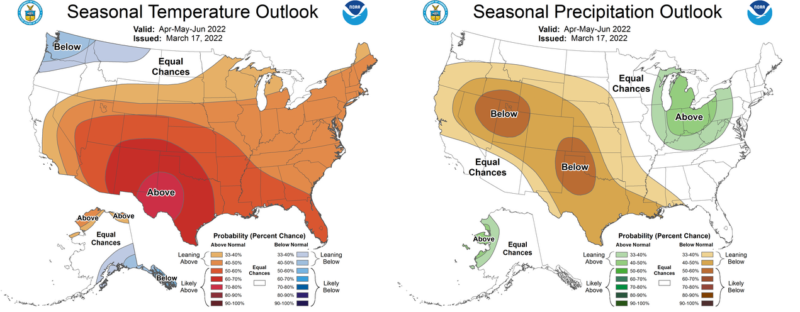Runoff Report and Season Fishing Forecast for Early June 2022
Posted on June 4th, 2022
Introduction, Current Conditions, and Long-Range Outlooks
Here in Yellowstone Country, winter snowpack and how this snowpack melts from late April through June play the most important roles in summer water supply for both fish and agriculture from early June through mid-September. June through mid-September temperatures and rainfall play a secondary role. Only after mid-September does day-to-day weather play the largest role in overall water levels and water quality. Winter and spring weather are thus very helpful in planning summer fishing trips to the region.
On the heels of low snowpack in 2020-2021 followed by a record warm, dry summer that came early and a dry winter, as of April 1 we were mired in severe to extreme drought throughout the region. Thankfully, we have had an exceptionally cool, wet spring that has done a great job in reducing the drought. It’s by no means gone, but conditions have improved. The following graphic shows we’re primarily in moderate drought, with some severe drought in Yellowstone Park. While this isn’t ideal, it’s better than we’ve seen since 2020.
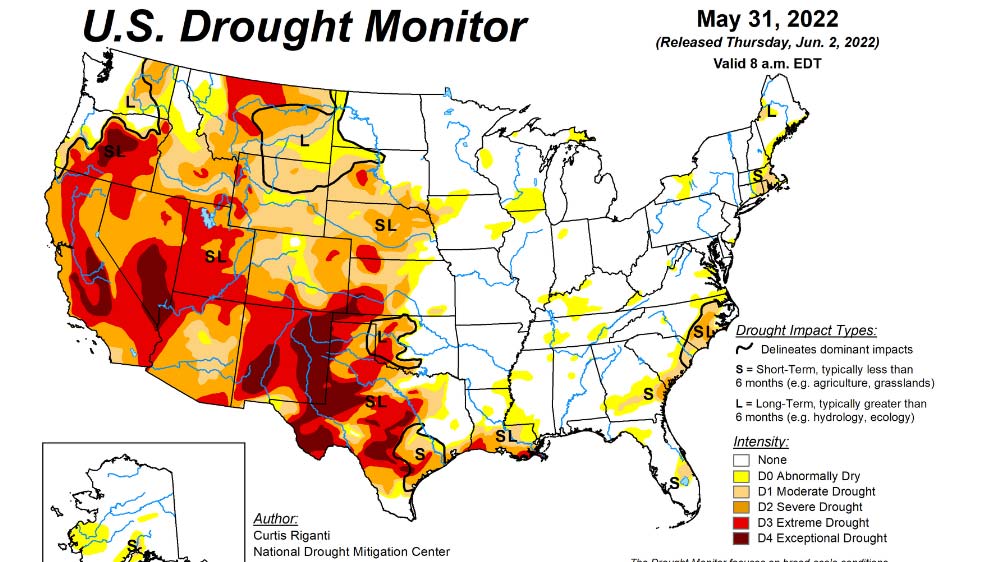
Moreover, snowpack for the date is extremely high. This does not reflect how much snow actually fell this past winter and spring. Instead it shows how much there is on the ground compared to average for this date. Since we’ve had such a cold, wet spring, a whole lot of snow remains to melt. In general, the later and slower the snow melts, the more of it goes into the ground rather than running straight off to North Dakota. Due to the high remaining snowpack and the exceptionally late melt, we expect water levels to be near-average from July through September, even with the drought.
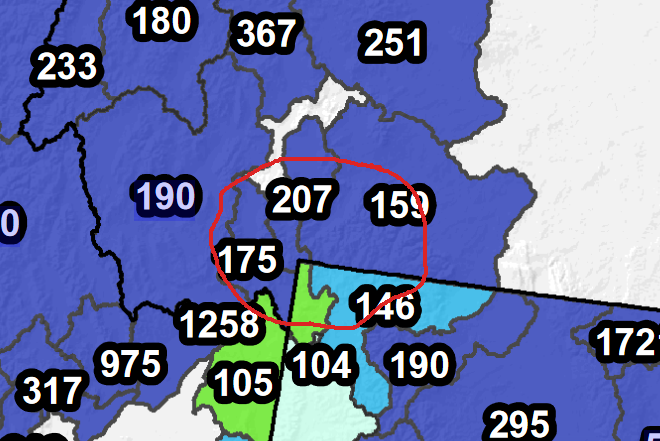
YCFF operations area (roughly) circled in red.
The abundant spring moisture and late melt means that most waters have not yet reached their peak streamflows for the year. On most streams this occurs between May 20 and June 1 in an average year. This year, most waters will reach peak flows in mid-June. Only geyser-heated waters draining low mountains in Yellowstone Park have already reached their peaks. The following graphic shows predicted flows for the Yellowstone River throughout the season. Combined with the graphic above and the weather forecast for the next two weeks, we expect the Yellowstone River to hit max flow around June 13–17. The Yellowstone generally drops into fishable condition about two weeks after it hits peak flow.
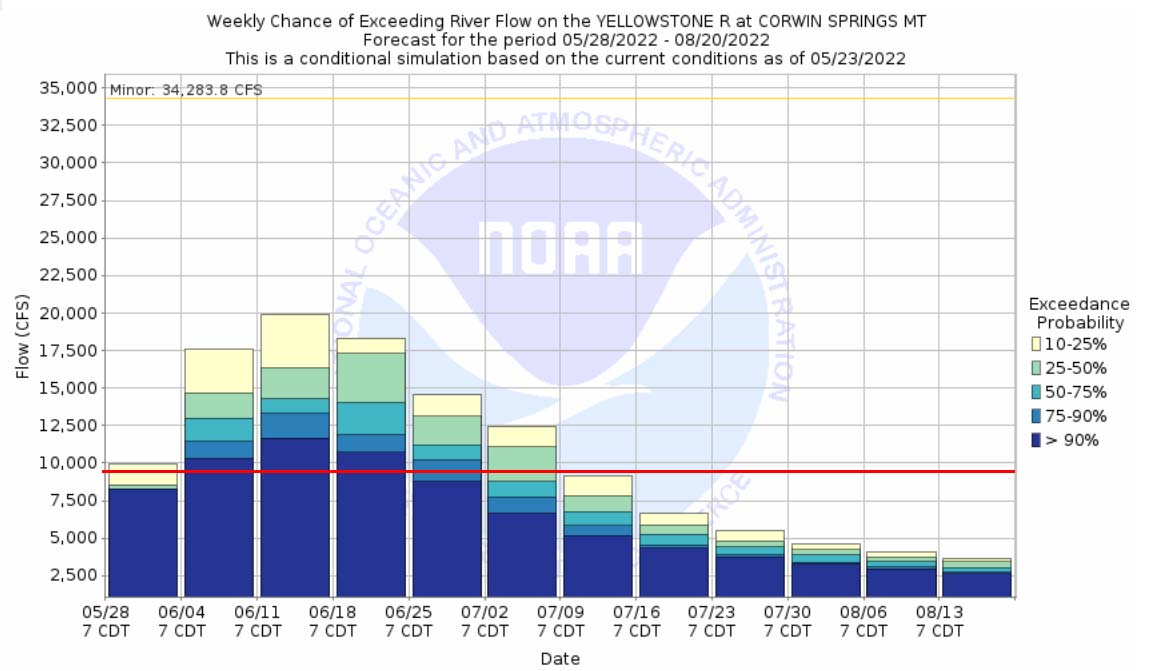
The thin red line indicates the likely flow rate at which the Yellowstone will become fishable this year. This hits the “50/50” prediction for forecast flows around the beginning of July. These forecasts tend to predict slightly higher flows than actually occur, and this forecast was made during a cold/wet spell.
Visit NOAA’s Climate Prediction Center for the full range of long-term outlooks as well as lots of information on ENSO, assorted oscillations, and other weather and climate info that goes right over my head.
Summary of Anticipated Water & Fishing Conditions
In a general sense, here’s what we expect for June through mid-September streamflow and fishing conditions. This is based on current conditions and the longer-range outlooks. While this isn’t a “weather forecast,” it’s now late enough into the year that only extreme, prolonged summer heat and drought will change this forecast substantially for the worse.
- The spring runoff is near its peak. Due to an extremely cold spring, peak snowmelt on all waters is occurring one to three weeks later than average. This is good for late summer flows, not so good for fishing right now.
- After the heavy melt hits and then recedes, the most consistent fishing is likely to occur from about July 4 through sometime in August. Due to the late melt, we DO NOT expect any poor conditions in August and September. It’s fish will just be spookier and more erratic then.
- Near-normal to slightly-below-normal streamflows are now certain, but only after mid-late July. The late runoff means that it is going to take a long time for the water to drop. The late summer low flows will not be extreme and should not have any large impact on the fishing conditions.
- Runoff has been late and will see below-median peak flows on most rivers, but will end on an average to slightly later than average date. The Yellowstone usually drops into fishable shape between June 25 and July 4. This year it will come in around July 1 barring extended late June heat.
- The most consistent fishing will occur in July and early August, but the entire July through October core season should see good water conditions. This is a huge improvement from early spring predictions, when we expected very bad conditions in August and September.
- We do not expect any widespread fishing restrictions due to heat and drought. Only rivers that always or almost always see restrictions (the Lower Madison, Jefferson, Smith, Sun, Shields, and other minor summer fisheries at low elevations in Montana) are likely to see 2:00 fishing closures. On some hot, sunny days in late July and August the late afternoon fishing will be poor, but this is always the case.
- Due to tinderbox conditions throughout most of the West, fires and smoke from both local and distant fires are likely to be very bad this year beginning in late July.
- Due to the winding-down of COVID (we hope) prompting high tourism, as well as the rapidly increasing population in the region, fishing pressure will be intense from the end of runoff through early October, assuming fires and stream closures allow for it. The quality of the fishing will not play any role in how many people are on the water. We are already seeing much more fishing pressure than used to be typical, including record-high bookings for all of spring.
Detailed Fishing Conditions by Water
There have been substantial changes to the following forecasts due to the abundant snow and cold weather we’ve enjoyed in April and early May. In particular, we no longer expect 2:00PM closures in late summer unless we have an extreme heat wave save on rivers that almost always have them, such as the lower Madison River.
Since runoff has now begun in earnest, we are growing much more confident about the accuracy of the following date ranges. If you haven’t booked your lodging or guide service, we suggest doing so ASAP since availability of both is now getting sparse.
Montana Fisheries
- Yellowstone River: Runoff will end between June 25 and July 4, with July 1 most likely. The Salmonfly hatch will occur for about a week immediately after runoff recedes. It is possible the earliest days of the hatch will see conditions too high and muddy to fish. The fishing will be best on slower, shallower sections of river in July and early August, but should be at least fair all season. Faster, deeper water upstream from Livingston should produce well all season. Only record heat and drought in July will change this prediction.
- Madison River: The Lower Madison will not experience any appreciable runoff and will be best prior to July 1. After July 4 it will generally run too warm after noon depending on day-to-day weather. The Upper Madison (really outside my ops area) will likewise probably not experience much of a runoff. It will be best from mid-June through late July.
- Boulder River: Runoff will end late due to intense recent snow. June 25 to July 4 is a reasonable window for the end of the melt, with July 1 most likely. The river will get too low to float by August 1, and perhaps sooner. High water temps and low flows will almost certainly be a problem even for wade-fishing in August due to this small river’s intense irrigation drawdowns. The Boulder seldom sees any fishing restrictions due to water levels or temperature, but in all honesty I expect areas downstream of Natural Bridge should be closed 24 hours a day in August, due as much to irrigation drawdowns as water temps.
- Stillwater River: Runoff will end around July 1 most likely. Upper sections will be too low to float around August 1. Lower portions downstream of the Rosebud confluence will remain high enough to float until at least September 1 and possibly through September. Late summer rains will be required for float-fishing to remain an option after roughly Labor Day. The best fishing will occur in July and August, but should be decent so long as flows remain high enough to allow floating. This river will offer our best “action/numbers/dry flies” fishing this year.
- Missouri River: No appreciable runoff will occur. The carp/walleye/pike water upstream from Canyon Ferry Reservoir will as always fish best from late July through early September. The trout water downstream of Canyon Ferry (including “Land of Giants”) will fish best from now through June.
- Private Lakes: Day-to-day weather is more important on the lakes than snowmelt. These lakes have warmed up very late. Frequently we see excellent hatches in mid–late May. We are still in “leech and streamer mode” due to the cold spring. This late start should keep fishing good well through June, possibly through July in the case of Burns Lake. Hot/bright weather thereafter the determining factor on when things get slow.
- Paradise Valley Spring Creeks: Fishing is always best on the creeks from early March through April, then again from about June 20 through July 20. Unfortunately, radically-increasing pressure on the creeks now means that many prime dates in June-July 2023 are now booked solid. We’re basically done guiding on these creeks except in March-April because of this.
- Other Waters: The Gallatin River will likely drop out of runoff around June 25 and possibly get too warm downstream of Gallatin Gateway by late July. Mountain small streams in Montana will generally fish best from July 15 through August, but may hang on into early September if summer is not too hot and dry. Public lakes in Montana will be best in June except for carp, which rise to hoppers on some lakes in late July and August.
Yellowstone Park Fisheries
- Yellowstone River: The Lake-Falls stretch opens July 1! This is a change from longstanding tradition. For decades this water opened July 15. We wish the early July closure remained in place to let the lake-run cutthroat finish the spawn in peace. That said, early July will almost certainly offer the best fishing here since the mid-1990s, since cutthroat numbers are increasing in general and almost none of them will have migrated back to the lake on the opener, in contrast to the previous opener which saw many fish already moving back to their winter haunts in Yellowstoen Lake. The fishing will remain good through July. The Grand Canyon from the Falls to the Lamar confluence will become fishable around June 20. The most consistent fishing (particularly if you prefer dry flies) will occur in July and early August, though the fishing should remain good until mid-October. The Black Canyon stretch from the Lamar to Gardiner will track similarly to the stretch downstream of Gardiner noted in the previous section.
- Gardner River: The lower Gardner downstream of Boiling River will be fishable on a day-to-day basis from the opening of the park season, joined by the stretch from Sheepeater Canyon to Boiling River around June 20. Consistent fishing will begin by June 25 and continue in both stretches through July and above Boiling River until early October. Below Boiling River will be too warm and weedy at the end of July and on through mid-September. The headwaters above Osprey Falls will come in around July 5–10 and remain good until mid-August.
- Lamar River & Tributaries: Runoff will end sometime in the first ten days of July depending on the water involved and the weather. The best fishing will occur in July and early August. The water will be low and slow and the fish heavily-pressured and spooky thereafter.
- Firehole River: The Firehole will not experience an appreciable runoff and will fish best between the park opener and June 20. The first hot/dry spell after June 20 will shut down fishing until after Labor Day. While conditions have improved in the Firehole drainage over the past few weeks, they’re still not ideal. In fact, snowpack is lower in this basin than anywhere else in the area.
- Gibbon River: The Gibbon upstream of Norris Geyser Basin will be fishable sometime between June 5 and June 10 and will be best before late July. Areas downstream of Norris Geyser Basin are unlikely to experience an appreciable runoff and will be best between the season opener and June 25. After June 25, the first hot spell will shut the fishing off until September 1. We will be guiding here at least two days in the upcoming week.
- Upper Madison River: Generally similar to the Firehole but will hang on for a few days after the first hot spell.
- Lakes in YNP: Ice-out has now happened on all lakes except perhaps Lewis and other high-elevation lakes in the southern part of the park (4+ hours from here). Travel to the lakes before mid-June will be a wet, sloppy mess due to mud and snowmelt. All will fish best through June, then trail off through July.
- Creeks in YNP: Meadow-type streams will become fishable between June 10 and the end of June, with those draining lakes becoming fishable towards the earlier end and those draining mountains falling into shape later. All will be best for the first month after they come in. Rough, mountain creeks will come into shape around the beginning of July and be best for a month to six weeks starting about a week after they fall into shape.
Mid-March Snowpack Update and Season Fishing Forecast
Posted on March 19th, 2022
Introduction, Current Conditions, and Long-Range Outlooks
Here in Yellowstone Country, winter snowpack and how this snowpack melts from late April through June play the most important roles in summer water supply for both fish and agriculture from early June through mid-September. June through mid-September temperatures and rainfall play a secondary role. Only after mid-September does day-to-day weather play the largest role in overall water levels and water quality. Winter weather is thus very helpful in planning summer fishing trips to the region.
On the heels of low snowpack in 2020-2021 followed by a record warm, dry summer that came early, we are currently in severe to extreme drought throughout the YCFF operations area. Montana is in worse shape as far as drought than any other regions in the West except for Oregon east of the Cascade Range and the state of Nevada. Unfortunately, current snowpack is very low, so these conditions are not likely to improve much. Current snowpack ranges from 74% to 86% of normal for the date in our ops area, with the two most important basins (the Yellowstone River basins in Wyoming/YNP and Montana) at 83% and 81% of normal, respectively.
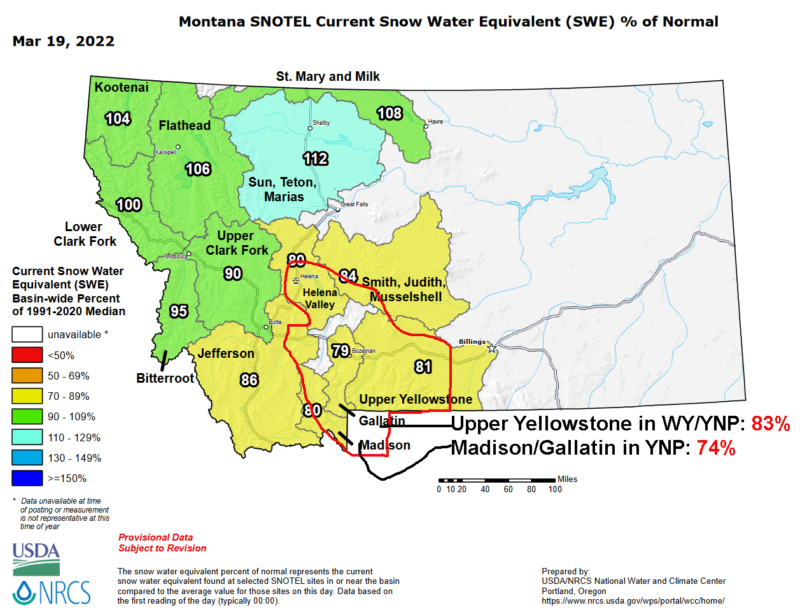
The culprit for the above low snowpack is simple: we had very little fall and early winter snow, lots of snow from about December 10 through New Year, almost none in January and most of February, and a little since. January and February snowfall were record-low in many areas throughout the region. The following graphic is from the Two Ocean Plateau Snotel, a high-elevation snow data sensor at 9240 feet near Yellowstone Park’s southern boundary, in the Wyoming portion of the Upper Yellowstone basin. Notice the flatline. That’s this year’s water. The smooth green line is mean snowpack for the date. The jerky green line is median snowpack for the date.

Unfortunately, the 6–10 and 8–14 day outlooks, the monthly outlook for March, and the 3-month outlook for April through June do not look promising for much improvement in the above numbers. The 8–14 day and three-month outlooks (the latter covers the entire spring runoff season) are provided below.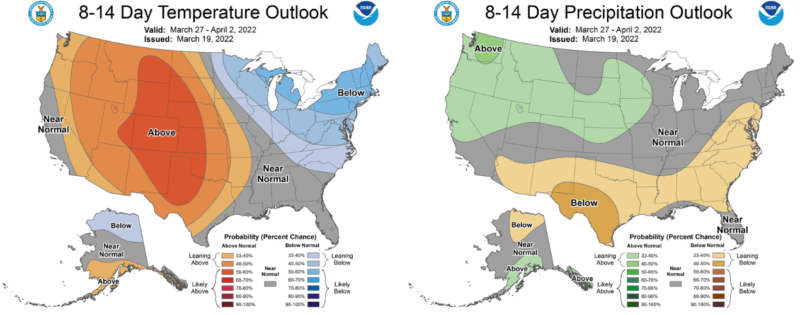
Summary of Anticipated Water & Fishing Conditions
In a general sense, here’s what we expect for June through mid-September streamflow and fishing conditions. This is based on current conditions and the longer-range outlooks. Think of the following as something like a weather forecast from a week out: it’s too early for specifics, but the general outline is probably accurate. Spring fishing conditions depend on day-to-day weather; we hope for a late and slow start to the spring snowmelt.
- The fishing and guiding seasons have already begun. Now (mid-March) through mid-April will probably offer the most consistent float-fishing of the entire season, with the exception of about a month in June-July.
- Below-normal snowpack and resulting summer streamflows are now certain. How low we go depends on how much moisture we get through mid-May and how the snow melts from late April onward. Record-low water in late summer is very possible.
- We anticipate a light snowmelt and an early end to the snowmelt cycle. The end point will depend on when the snow starts melting in earnest.
- Late June and July fishing conditions will be better than August and early September conditions.
- The fish are likely to be spooky and difficult for much of the season.
- 2:00PM fishing closures will be common to universal across our operations area between July 25 and August 25. Closures outside of these timeframes are possible if we have an early extreme warmup as we did in 2021.
- Complete fishing closures are possible on many waters in August if we have a repeat of last summer’s record heat and drought. This could include total fishing closures in Yellowstone Park. These are much less likely in Montana.
- Fires and smoke from both local and distant fires are likely to be very bad this year beginning in mid-July.
- Due to the winding-down of COVID (we hope) prompting high tourism, as well as the rapidly increasing population in the region, fishing pressure will be intense from the end of runoff through early October, assuming fires and stream closures allow for it. The quality of the fishing will not play any role in how many people are on the water. We are already seeing much more fishing pressure than is typical for season, including record-high bookings for March.
Detailed Fishing Conditions by Water
The following information is still quite general, as we still don’t know exactly how much snow we will get or when and how this snow will melt. In general, more snow and a later melt will push things towards the latter end of the following date ranges, increase overall summer streamflows, improve the fishing in late July and August, and reduce fishing quality in June, while little moisture for the remainder of winter and early spring and an early start to the melt will have opposite effects.
Fishing beginning in early-mid September depends more on day-to-day weather than snowmelt. In general, the fishing AFTER September 15 will probably be better than the fishing BEFORE unless we see unusual weather. We DID see unusual weather in 2021; early September was cool and wet while late September was warm and bright, so fishing was much better in early September last year. This was very odd.
Montana Fisheries
- Yellowstone River: Runoff will end between June 10 and June 20. The fishing will be best for the month following. Hot, bright days in August and early September will be very difficult, particularly in shallow, gentle sections of river. 2:00PM fishing closures are very likely on the entire Yellowstone River from YNP to Laurel from sometime in late July until sometime in late August unless we are blessed with a late runoff and a cool, wet June.
- Madison River: The Lower Madison will not experience any appreciable runoff and will be best prior to June 10. After June 15 it may be too warm after noon depending on day-to-day weather. The Upper Madison (really outside my ops area) will likewise probably not experience much of a runoff. It will be best from mid-June through mid-July.
- Boulder River: Runoff will end between June 10 and June 20, with June 15 most likely. The river is likely to get too low to float around July 10, and perhaps sooner. High water temps and low flows will almost certainly be a problem even for wade-fishing in August due to this small river’s intense irrigation drawdowns.
- Stillwater River: Runoff will end between June 10 and June 25, with June 15-20 most likely. Upper sections will be too low to float around July 10-15. Lower portions downstream of the Rosebud confluence will be high enough to float through late August. The best fishing will occur in July.
- Missouri River: No appreciable runoff will occur. It’s actually pretty unlikely flows from Holter Dam will change much at all from the current 3000-odd CFS levels this spring. The carp/walleye/pike water upstream from Canyon Ferry Reservoir will as always fish best from late July through early September. The trout water downstream of Canyon Ferry (including “Land of Giants”) will fish best from now through June.
- Private Lakes: Day-to-day weather is more imporant on the lakes than snowmelt. These lakes should fish well from early April through at least mid-June, with hot/bright weather thereafter the determining factor on when things get slow.
- Paradise Valley Spring Creeks: Fishing is always best on the creeks from early March through April, then again from about June 20 through July 20. Unfortunately, radically-increasing pressure on the creeks now means that many prime dates in June-July 2023 are now booked solid. We’re basically done guiding on these creeks except in March-April because of this.
- Other Waters: The Gallatin River will likely drop out of runoff in mid-June and possibly get too warm by late July. The Jefferson River will drop from runoff by mid-June and probably be too warm the instant it does. Immense fish kills occurred on this river in 2021 and this year will be no better. Many portions may honestly never recover, given the likely future flows and water temps current climate models predict. Montana small streams will generally fish best in July but will also be okay in August provided they don’t get TOO skinny. Public lakes in Montana will be best in May and June.
Yellowstone Park Fisheries
- Yellowstone River: The Lake-Falls stretch always opens July 15. It will be best for the two weeks thereafter. The Grand Canyon from the Falls to the Lamar confluence is unlikely to experience an unfishably-high runoff. It should fish well with nymphs and streamers as soon as it opens on the Saturday of Memorial Day Weekend, though it won’t necessarily be “pretty.” 2:00 closures are likely in August, though only because YNP tends to use a hammer as its only tool in fisheries management–in reality, this section of the Yellowstone stays under 70 degrees and is deep enough to offer good cover even in awful drought years. The Black Canyon section downstream of the Lamar confluence tracks similarly to the Yellowstone River outside the park.
- Gardner River: The Gardner will be fishable on a day-to-day basis from the park opener through mid-June, then be good through early July throughout and after early July only upstream from Boiling River. Downstream of Boiling River will be too warm until mid-September. Note that the Gardner saw overwhelming pressure in 2021 and generally fished poorly because of it.
- Lamar River & Tributaries: Runoff will end between June 15 and July 1 on Slough Creek and between June 20 and July 4 elsewhere. The best fishing will be for the month thereafter. Late August and early September will see low water and spooky fish, particularly on Slough Creek. Roadside areas saw overwhelming pressure in 2021 and 2022 might well be worse.
- Firehole River: The Firehole will not experience an appreciable runoff and will fish best between the park opener and June 10. The first hot/dry spell between June 10 and June 20 will shut down fishing until after Labor Day. We did not guide on the Firehole in 2021 and almost certainly will not in 2022, either. If current climate models continue, the Firehole will cease to be a relevant fishery downstream of Old Faithful by 2030 due to repeated fish kills associated with high water temperatures.
- Gibbon River: The Gibbon is unlikely to experience an appreciable runoff and will be best between June 1 and June 15. After June 15, the first hot spell will shut the fishing off until September 1.
- Upper Madison River: Generally similar to the Firehole but will hang on for a few days after the first hot spell.
- Lakes in YNP: Ice-out will depend on day-to-day weather but should occur around Opening Day. All should be accessible from this point onward due to limited snow on the trails. All will fish best from ice-out (or Opening Day, whichever comes second) through June, then trail off through July.
- Creeks in YNP: Meadow-type streams will become fishable between June 5 and June 25, with those draining lakes becoming fishable towards the earlier end and those draining mountains falling into shape later. All will be best for the first month after they come in. Rough, mountain creeks will come into shape between June 15 and July 4 and be best for a month starting about a week after they fall into shape.
Snowpack Report and Summer Streamflow and Fishing Outlook: Early March Update
Posted on March 3rd, 2022
Introduction, Current Conditions, and Long-Range Outlooks
Here in Yellowstone Country, winter snowpack and how this snowpack melts from late April through June play the most important roles in summer water supply for both fish and agriculture from early June through mid-September. June through mid-September temperatures and rainfall play a secondary role. Only after mid-September does day-to-day weather play the largest role in overall water levels and water quality. Winter weather is thus very helpful in planning summer fishing trips to the region.
On the heels of low snowpack in 2020-2021 followed by a record warm, dry summer that came early, we are currently in severe to extreme drought throughout the YCFF operations area. Montana is in worse shape as far as drought than any other region in the West except for Oregon east of the Cascade Range. Unfortunately, current snowpack is very low, so these conditions are not likely to improve much. Current snowpack ranges from 77% to 85% of normal for the date in our ops area, with the two most important basins (the Yellowstone River basins in Wyoming and Montana) at 85% and 81% of normal, respectively.
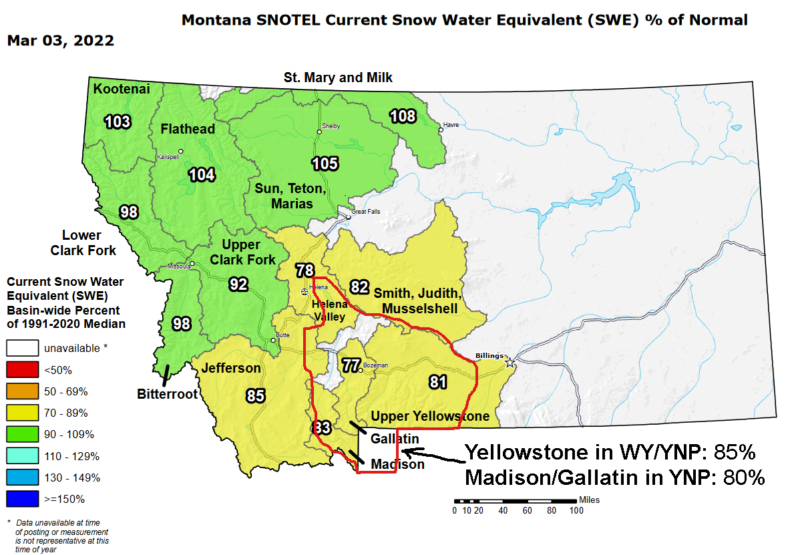
Montana snowpack as of March 3, 2022. Our operations area is circled in red.
The culprit for the above low snowpack is simple: we had very little fall and early winter snow, lots of snow from about December 10 through New Year, and almost none since. January and February snowfall were record-low in many areas throughout the region. The following graphic is from the Two Ocean Plateau Snotel, a high-elevation snow data sensor at 9240 feet near Yellowstone Park’s southern boundary, in the Wyoming portion of the Upper Yellowstone basin. Notice the flatline. That’s this year’s water. The smooth green line is mean snowpack for the date. The jerky green line is median snowpack for the date.

The past week has been awful for snowpack, with temperatures reaching into the 40s even in the mountains and touching the mid-50s at valley level. Low-elevation snow is almost gone. Things do look to improve between now and mid-March, however. Cold, wet weather is in the forecast more or less as far as the eye can see. We hope it materializes. Such outlooks have been present throughout most of the winter but have rarely come to pass. The following graphics show the composite temperature and precip outlooks for the 6–10 day period and through March. This information is at NOAA’s Climate Prediction Center.
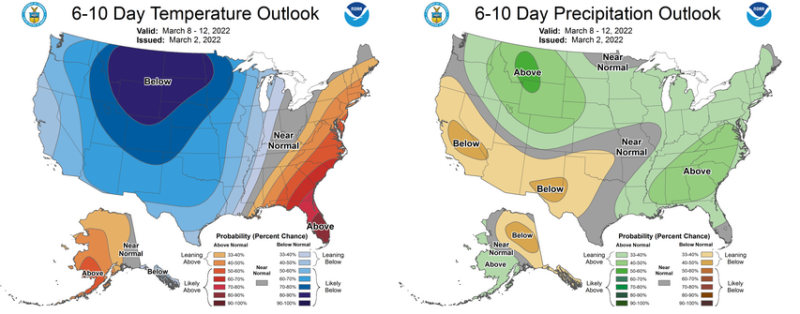
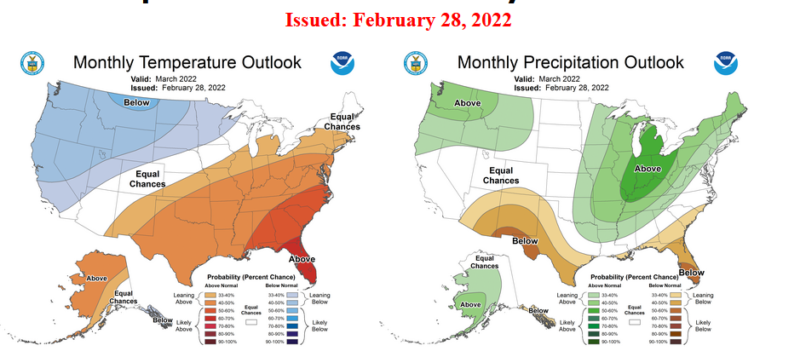
Summary of Anticipated Water & Fishing Conditions
In a general sense, here’s what we expect for June through mid-September streamflow and fishing conditions. This is based on current conditions and the longer-range outlooks. Think of the following as something like a weather forecast from a week out: it’s too early for specifics, but the general outline is probably accurate. Spring fishing conditions depend on day-to-day weather; we hope for a late and slow start to the spring snowmelt.
- Below-normal snowpack and resulting summer streamflows are now basically certain. How low we go depends on how much moisture we get through mid-May and how the snow melts from late April onward. Record-low water in late summer is very possible.
- We anticipate a light snowmelt and an early end to the snowmelt cycle. The end point will depend on when the snow starts melting in earnest.
- Late June and July fishing conditions will generally be better than August and early September conditions.
- The fish are likely to be spooky and difficult for much of the season.
- If we have a hot/dry summer, 2:00PM fishing closures will be common to universal across our operations area between July 25 and August 25. Closures outside of these timeframes are possible if we have an early extreme warmup as we did in 2021.
- Fires and smoke from both local and distant fires are likely to be very bad this year beginning in mid-July.
- Due to the winding-down of COVID (we hope) prompting high tourism, as well as the rapidly increasing population in the region, fishing pressure will be intense from the end of runoff through early October, assuming fires and stream closures allow for it. The quality of the fishing will not play any role in how many people are on the water.
Detailed Fishing Conditions by Water
The following information is still quite general, as we still don’t know exactly how much snow we will get or when and how this snow will melt. In general, more snow and a later melt will push things towards the latter end of the following date ranges, increase overall summer streamflows, improve the fishing in late July and August, and reduce fishing quality in June, while little moisture for the remainder of winter and early spring and an early start to the melt will have opposite effects.
Fishing beginning in early-mid September depends more on day-to-day weather than snowmelt. In general, the fishing AFTER September 15 will probably be better than the fishing BEFORE unless we see unusual weather. We DID see unusual weather in 2021; early September was cool and wet while late September was warm and bright, so fishing was much better in early September last year. This was very odd.
Montana Fisheries
- Yellowstone River: Runoff will end between June 5 and June 25, with June 15-20 now most likely. The fishing will be best for the month to six weeks after runoff starts to trail off. Hot, bright days in August and early September will be very difficult, particularly in shallow, gentle sections of river.
- Madison River: The Lower Madison will not experience any appreciable runoff and will be best prior to June 15. After June 20 it may be too warm after noon depending on day-to-day weather. The Upper Madison (really outside my ops area) will likewise probably not experience much of a runoff. It will be best from mid-June through mid-July.
- Boulder River: Runoff will end between June 1 and June 20, with June 15 most likely. The river is likely to get too low to float no later than July 15, and perhaps sooner. High water temps and low flows will almost certainly be a problem even for wade-fishing in August due to this small river’s intense irrigation drawdowns.
- Stillwater River: Runoff will end between June 1 and June 25, with June 15-20 most likely. Upper sections will be too low to float around July 10-15. Lower portions downstream of the Rosebud confluence will be high enough to float through late August. The best fishing will occur in July.
- Missouri River: No appreciable runoff will occur. It’s actually pretty unlikely flows from Holter Dam will change much at all from the current 3000-odd CFS levels this spring. The carp/walleye/pike water upstream from Canyon Ferry Reservoir will as always fish best from late July through early September. The trout water downstream of Canyon Ferry (including “Land of Giants”) will fish best from now through June.
- Private Lakes: Day-to-day weather is more imporant on the lakes than snowmelt. These lakes should fish well from early April through at least mid-June, with hot/bright weather thereafter the determining factor on when things get slow.
- Paradise Valley Spring Creeks: Fishing is always best on the creeks from early March through April, then again from about June 20 through July 20. Unfortunately, radically-increasing pressure on the creeks now means that many prime dates in June-July 2023 are now booked solid. We’re basically done guiding on these creeks except in March-April because of this.
- Other Waters: The Gallatin River will likely drop out of runoff in mid-June and possibly get too warm by late July. The Jefferson River will drop from runoff by mid-June and probably be too warm the instant it does. Immense fish kills occurred on this river in 2021 and this year will be no better. Many portions may honestly never recover, given the likely future flows and water temps current climate models predict. Montana small streams will generally fish best in July but will also be okay in August provided they don’t get TOO skinny. Public lakes in Montana will be best in May and June.
Yellowstone Park Fisheries
- Yellowstone River: The Lake-Falls stretch always opens July 15. It will be best for the two weeks thereafter. The Grand Canyon from the Falls to the Lamar confluence may not experience an unfishable runoff. If it does become too high, it will clear no later than June 10-15. It will be best in late June and July but should produce for the remainder of the season if it does not get too warm. The Black Canyon section downstream of the Lamar confluence tracks similarly to the Yellowstone River outside the park.
- Gardner River: The Gardner will be fishable on a day-to-day basis from the park opener through mid-June, then be good through early July throughout and after early July only upstream from Boiling River. Downstream of Boiling River will be too warm until mid-September. Note that the Gardner saw overwhelming pressure in 2021 and generally fished poorly because of it.
- Lamar River & Tributaries: Runoff will end between June 15 and July 1 on Slough Creek and between June 20 and July 4 elsewhere. The best fishing will be for the month thereafter. Late August and early September will see low water and spooky fish, particularly on Slough Creek. Roadside areas saw overwhelming pressure in 2021 and 2022 might well be worse.
- Firehole River: The Firehole will not experience an appreciable runoff and will fish best between the park opener and June 10. The first hot/dry spell between June 10 and June 25 will shut down fishing until after Labor Day.
- Gibbon River: The Gibbon is unlikely to experience an appreciable runoff and will be best between June 1 and June 15. After June 15, the first hot spell will shut the fishing off until September 1.
- Upper Madison River: Generally similar to the Firehole but will hang on for a few days after the first hot spell.
- Lakes in YNP: Ice-out will depend on day-to-day weather but should occur around Opening Day. All should be accessible from this point onward due to limited snow on the trails. All will fish best from ice-out (or Opening Day, whichever comes second) through June, then trail off through July.
- Creeks in YNP: Meadow-type streams will become fishable between June 5 and June 25, with those draining lakes becoming fishable towards the earlier end and those draining mountains falling into shape later. All will be best for the first month after they come in. Rough, mountain creeks will come into shape between June 15 and July 4 and be best for a month starting about a week after they fall into shape.
